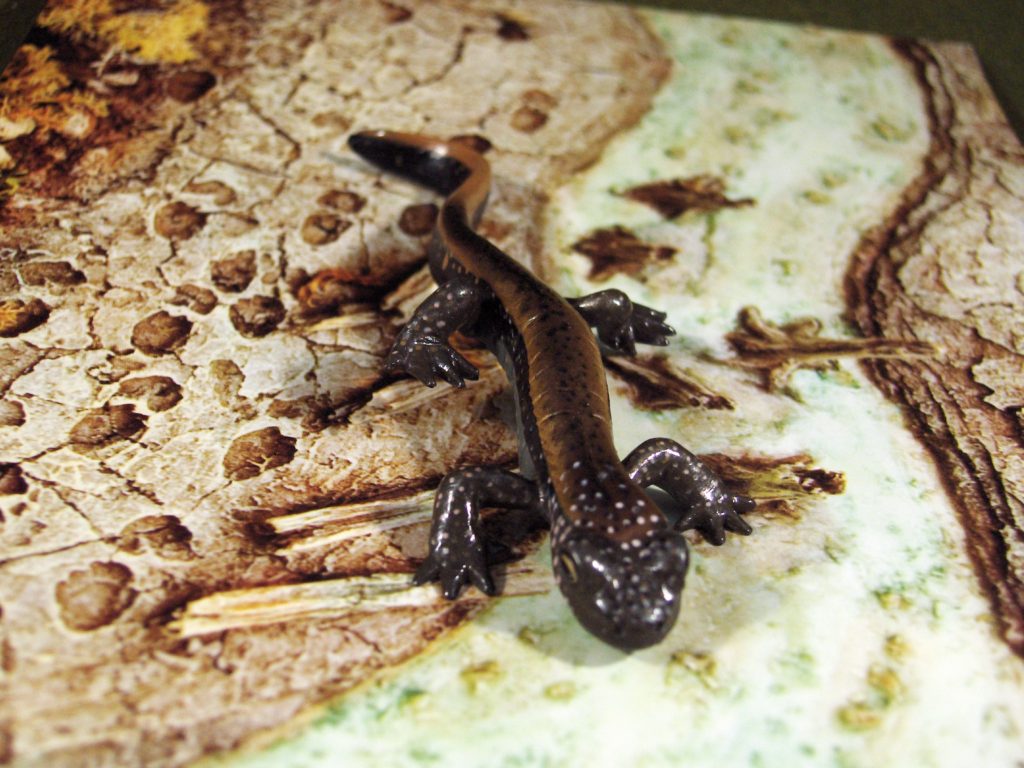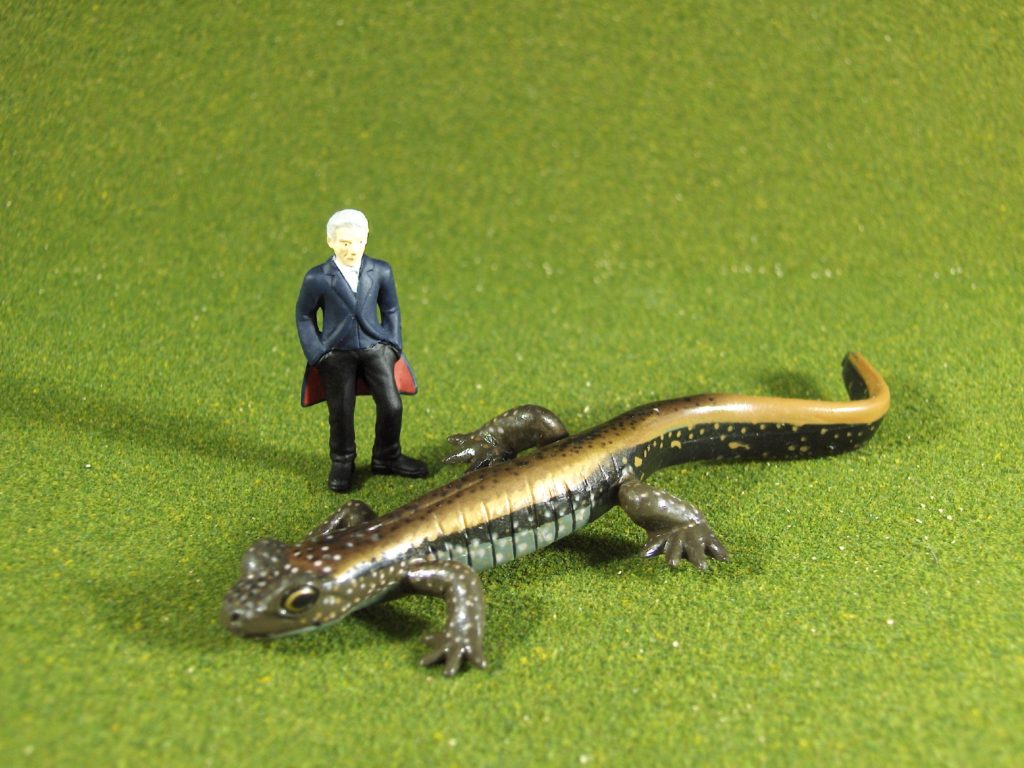So just going over my shelves, wondering what I could review, and my eyes fell on what might be the original Colorata set (or one of them)–their River Life set! What sets this one apart is the diversity–3 frogs, several fish, and one exclusive never-again-released salamander, a Japanese Clawed Salamander Onychodactylus japonicus (Houttuyn, 1882). This figure is unique because it is the only caudate amphibian made by Colorata so far, and the only figure that was not re-released in a special set (like the frogs) or resculpted and revised for the Freshwater Fishes box several years later. And, as I just discovered (unless something changes while writing…) it’s the first amphibian on the blog!

This figure represents a member of the salamander family Hynobiidae, an Asian and European-Russian family with many species unique to Japan. They are considered relatively primitive, and share a clade with the giant salamanders. Onychodactylus species are lungless and apparently aquatic. They, like other members of the family, are external fertilizers and the parents guard the eggs.

The Japanese clawed salamander is found in temperate forests and streams on the Japanese islands of Honshu and Shikoku. Like other salamanders they are predators of smaller organisms, primarily invertebrates. They are listed as least concern, but given the state of many modern amphibians…and that need for cool environments…we’ll see how it goes.

These salamanders reach about 13-19 cm long; the figure itself is about 13 cm long as well, so it is roughly 1:1. The figure has been carefully sculpted to look, and almost feel, like a real animal. There are numerous tiny details in the figure, including very detailed eyes and folds along the sides. I am not sure if it is a production artefact or if it is intentional, but there is a slight bend in my figure at the base of the tail, as if the body is meant to rest with the tail drooping down a bit. In practice, it makes the figure look like the mid body is lifted off the ground slightly.

In terms of colour, there is a lot going on. The base plastic is a light grey along the belly and lowest part of the sides. The midline of the body and most of the lower part of the tail is based in black. The dorsal surface and top of the tail is copper. Along the very middle of the back is a thin sculpted depression to the mid torso, picked out in black, Throughout the body there are blacks spots, dots and speckles on the back and tail; on the head and sides there are white dots. From what I can tell from online photos, there is quite a variety of colours and patterns in these salamanders, from mostly black with copper or pink on the back to patterns like this figure, to even more elaborate patterns featuring these and more colours. Kudos to Colorata for choosing a pretty high difficulty!

A lot of care has clearly been put into this figure, and I can’t even say something like ‘Colorata learned a lot before releasing this series’ because I’m pretty sure this was one of their first sets (other than an ocean animals one, of which I have a couple sharks). I am guessing this because, among many things, the ‘booklet’ that this set comes with is actually just a folding card, unlike the modern incarnations that have literal small books. And unlike current info books, this one is entirely in Japanese script, except for the numbers for lengths and…the names of the animals, which are Japanese names. There is no English at all. Even on the belly markings, the name is written as the Japanese name; later models have an English name stamped on. The belly also has a date, which is really the big clue–marked 2003, this is the earliest one I have noticed.

Which is why, I’m sorry to say, this set is no longer around; I got mine in the mid/late 2000s, and then they retired it. The fish were revised and re-sculpted (and added to) into the Freshwater Fish set. The frogs were released in a special box set for a little while. And the salamander was…lost to time and space. So while I really want to tell people to get this figure, it’s beautiful and belongs in collections; or get one for your kids (Colorata are tough, it’s a single piece, it would be fine to play with); or track down the whole set, I can’t. Occasionally they might show up on auction sites (in Japan) but this particular figure is one of those ones that is often difficult to find…and possibly afford (depends who notices). What is really devastating is that clearly we need a whole box set from Colorata of salamanders/non-frog amphibians (they have a frogs box set). Really, we need more salamander figures overall! But if you can, track this one down.
Disclaimer: links to Ebay and Amazon on the AnimalToyBlog are affiliate links, so we make a small commission if you use them. Thanks for supporting us!




Wonderful figure. For my Synoptic Collection I have the Kaiyodo version of this species. Even if it was available, at 13 cm, this figure might be too big for me. But, I am curious (unless I missed it in the text somewhere), is the base in the first pic part of the figure? I like figures on bases (at least smaller species).
No, the base is from something else (a LotR Warg!). But it was good to kind of hide the bend in the body. Like the three frogs (and the sculpin and loach) there was no base.